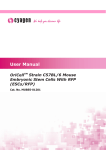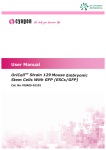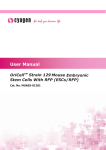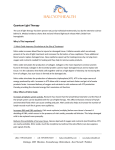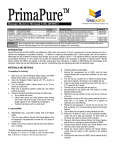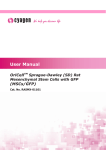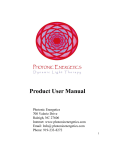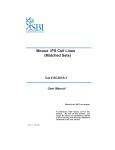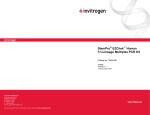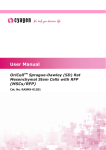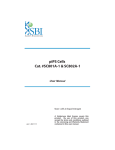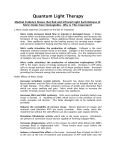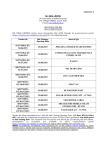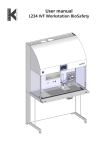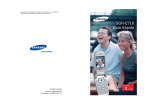Download User Manual - Cyagen Biosciences
Transcript
User Manual OriCellTM Strain C57BL/6 Mouse Embryonic Stem Cells (ESCs) Cat. No. MUBES-01001 Table of Contents Contents and Storage …………………………………………………………………………………… 3 Product Introduction …………………………………………………………………………………… 3 Cell Characteristics and Identity ………………………………………………………………… 3 Product Applications …………………………………………………………………………………… 4 General Handling Principles ………………………………………………………………………… 4 Gelatin Coating of Tissue Culture Vessels for MEFs ………………… …………………… 4 Culturing OriCellTM Strain C57BL/6 Mouse ESCs Thawing and Establishing of MEF Feeder Cells ……………………………………………… 5 Thawing and Establishing of OriCell TM Strain C57BL/6 Mouse ESCs ………………… 6 Passaging OriCell TM Strain C57BL/6 Mouse ESCs …………………………………………… 8 Differentiation of OriCell TM Strain C57BL/6 Mouse ESCs ………………………………… 9 Cryopreservation of OriCell TM Strain C57BL/6 Mouse ESCs …………………………… 11 Appendix …………………………………………………………………………… 12 Troubleshooting ………………………………………………………………………………………… 12 Related products ……………………………………………………………………………………… 14 Refenrences ……………………………………………………………………………………………… 14 Technical Support ………………………………………………………….…… 15 CONTENTS AND STORAGE Product Name Strain C57BL/6 Mouse Embryonic Stem Cells Catalog No. MUBES-01001 Amount per Vial 1×106 Cells Cryopreserved At Twentieth Passage Storage Condition Liquid Nitrogen CAUTION: Please handle this product as a potentially biohazardous material. This product contains Dimethyl Sulfoxide (DMSO), a hazardous material, in the freezing medium. PRODUCT INTRODUCTION Embryonic Stem Cells (ESCs) are pluripotent cells derived from the inner cell mass of blastocysts. These cells are able to differentiate into all derivatives of the primary germ layers, including ectoderm, endoderm, and mesoderm, thus generating every cell type in the body. Different from most other stem cells, ESCs are capable of self-renewal indefinitely. Because of their plasticity and potentially unlimited capacity for self-renewal, ES cell therapies have been proposed for regenerative medicine and tissue replacement. OriCellTM Strain C57BL/6 Mouse ESCs maintain diploid karyotype after extended passages in vitro. These cells express specific clusters of different proteins for ESCs, and are capable of forming embryoid bodies in vitro and developing teratomas in nude mice. Cyagen OriCellTM Strain C57BL/6 Mouse ESCs are derived from the inner cell mass of strain C57BL/6 Mouse blastocysts (at 3.5 dpc) and cultured on γ-ray irradiated mouse embryonic fibroblasts as feeder cells in OriCell TM Mouse ESC Growth Medium. In addition, these cells have been tested for: Exogenous Factors: bacterial/fungal contamination, mycoplasma contamination, and endotoxin contamination. Characteristics: post-thaw viability, cell cycle, verification of undifferentiated state, and differentiation potential. This product is intended for laboratory research use only. It is not intended for diagnostic, therapeutic, clinical, household, or any other applications. IMPI0024A3 MUBES-01001 Page 3 of 14 CELL CHARACTERISTICS AND IDENTITY Ability to differentiate into all derivatives of the three primary germ layers. Reproduce indefinitely under proper conditions. Positive for pluripotent stem cell markers Oct4, SSEA-1 and Nanog (≥ 90%), negative for SSEA-3 and SSEA-4 (≤ 5%) PRODUCT APPLICATIONS OriCellTM Strain C57BL/6 Mouse Embryonic Stem Cells (ESCs) are potent tools for basic and applied research in diverse fields, including basic mechanism involved in developmental procedure and disorder, regenerative biology and potential therapies. Specially, ESCs are a valuable utility to make genetically modified mice by introducing mutations into the mouse germ line. GENERAL HANDLING PRINCIPLES 1. Aseptic handling of the product is necessary throughout. 2. Once the cells have been established, always freeze several vials of OriCellTM C57BL/6 Mouse ESCs as a backup. 3. Establish and maintain Cyagen OriCell TM Strain C57BL/6 Mouse Embryonic Stem Cells on mouse embryonic fibroblasts (MEFs) feeder layers. We recommend using Cyagen OriCellTM Strain ICR MEFs (Irradiated) for culturing mouse ESCs. 4. For general maintenance of cells, we recommend the seeding density to be 2.0-2.5 ×104cells/cm2. 5. Do not let OriCellTM C57BL/6 Mouse ESCs overgrow as it will result in contact between the colonies. We recommend that the Mouse ESCs are routinely passaged every 48 hrs. Gelatin Coating of Tissue Culture Vessels for Mouse Embryonic Fibroblasts (MEFs) Materials Required: Gelatin Solution (Cat. No. GLT-11301) Gelatin Coating of Tissue Culture Vessels 1. Add sufficient Gelatin Solution into the culture vessel to completely cover its base. 2. Swirl until Gelatin Solution coats the entire base of vessel. Let it sit for at least 30 minutes at room temperature. IMPI0024A3 MUBES-01001 Page 4 of 14 3. Aspirate off all of the Gelatin Solution and allow the residual amount to evaporate by leaving the vessel sitting open in the laminar flow hood/biological safety cabinet for no more than 30 minutes. 4. Enclose the culture vessel once it has dried. Note: Gelatinized dishes or flasks can be stored at 4°C for no more than 2 weeks, provided they remain sterile. THAWING AND ESTABLISHING MOUSE EMBRYONIC FIBROBLASTS (MEFs) Materials Required Gelatin Solution (Cat. No. GLT-11301) OriCellTM Strain ICR Mouse Embryonic Fibroblasts (Cat. No. MUIEF-01002) OriCellTM Mouse Embryonic Fibroblast Growth Medium (Cat. No. MUXEF-90011) Thawing and Establishing MEFs 1. Pre-warm the OriCellTM MEF Growth Medium to 37°C. 2. Add 9 mL of OriCellTM MEF Growth Medium to a 15 mL conical tube. 3. Remove the cryovial of OriCellTM Strain ICR MEFs from liquid nitrogen. Quickly thaw the vial in a 37°C water bath until the last ice crystal disappears. For optimal results, be sure to finish the thawing procedure within 3 minutes. Be careful not to submerge the entire vial. Maximum cell viability is dependent on the rapid and complete thawing of frozen cells. Note: Results will be less than optimal if the cells are thawed for more than 3 minutes 4. As soon as the cells are completely thawed, disinfect the outside of the vial with 70% v/v ethanol. 5. Use a pipette to transfer the cells to the 15 mL conical tube containing OriCellTM MEF Growth Medium inside a biosafety cabinet. Be careful not to introduce any bubbles during the transfer process. 6. Rinse the vial with 1 mL of medium to reduce cell loss. Subsequently transfer this 1mL of cell suspension to the conical tube. 7. Gently mix the cell suspension by slowly pipetting up and down. Be careful not to introduce any bubbles. 8. Centrifuge the cell suspension at 250 x g for 5 minutes. 9. Carefully aspirate off as much of the supernatant as possible and add 3 mL of fresh OriCellTM MEF Growth Medium (pre-warmed to 37°C). 10. Gently resuspend the cells in OriCellTM MEF Growth Medium. IMPI0024A3 MUBES-01001 Page 5 of 14 11. Seed the cells into 6-well plates pre-coated with Gelatin Solution (or other appropriate flasks) and add sufficient OriCell TM MEF Growth Medium. Gently rock the culture plate to evenly distribute the cells. Note: We recommend the seeding density of MEFs to be 2.0-3.0×104cells/cm2. 12. Incubate at 37°C in a 5% CO2 humidified incubator. 13. The next day, change the medium with fresh OriCell TM MEF Growth Medium (pre-warmed to 37°C). Note: 1. If the next day thawing of the embryonic stem cells is performed, the medium can be changed directly to embryonic stem cell growth medium. 2. Thawing the feeder cells should be performed at least one day before thawing embryonic stem cells. 3. The feeder cells should be used as soon as possible once thawed. Fig. 1 Cyagen OriCellTM Mouse Embryonic Fibroblasts (Irradiated) plated on culture vessels coated with 0.1% gelatin THAWING AND ESTABLISHING OriCellTM STRAIN C57BL/6 Mouse EMBRYONIC STEM CELLS (ESCs) Materials Required: Gelatin Solution (Cat. No. GLT-11301) OriCellTM Strain C57BL/6 Mouse Embryonic Stem Cells (Cat. No. MUAES-01001) OriCellTM Mouse Embryonic Stem Cell Growth Medium (Cat. No. MUXES-90011) Thawing and Establishing Strain C57BL/6 Mouse ESCs 1. Pre-warm the OriCellTM Mouse ESC Growth Medium and 1×PBS to 37°C. IMPI0024A3 MUBES-01001 Page 6 of 14 2. Add 9 mL of OriCellTM Mouse ESC Growth Medium to a 15 mL conical tube. 3. Remove the cryovial of OriCellTM Strain C57BL/6 Mouse ESCs from liquid nitrogen. 4. Quickly thaw the vial in 37°C water bath until the last ice piece disappears. For optimal results, be sure to finish the thawing procedure within 3 minutes. Be careful not to submerge the entire vial. Maximum cell viability is dependent on the rapid and complete thawing of frozen cells. Note: Results will be less than optimal if the cells are thawed for more than 3 minutes 5. As soon as the cells are completely thawed, disinfect the outside of the vial with 70% v/v ethanol. 6. In a laminar flow hood, use pipette to transfer the cells to the conical tube containing OriCellTM Mouse ESC Growth Medium. Note: Be careful not to introduce any bubbles during the transfer process. 7. Rinse the vial with 1 ml of medium to reduce the loss of cell and then transfer the cell suspension to the conical tube. 8. Gently mix the cell suspension by slowly pipetting up and down. Be careful not to introduce any bubbles. 9. Centrifuge the cell suspensions at 250 x g for 5 minutes. 10. Carefully aspirate as much of the supernatant as possible and add 3 mL of fresh OriCellTM Mouse ESC Growth Medium (pre-warmed to 37°C). 11. Gently re-suspend the cells in OriCellTM Mouse ESC Growth Medium. 12. Plate the cells into TWO T25 flasks and add sufficient OriCellTM Strain C57BL/6 Mouse ESCs. Gently rock the culture flask to evenly distribute the cells. 13. Incubate at 37°C in a 5% CO2 humidified incubator. 14. The next day, change the medium with fresh OriCellTM Strain C57BL/6 Mouse ESCs (pre-warmed to 37°C). Note: Changing Medium 1. Warm an appropriate amount of OriCellTM Mouse ESC Growth Medium to 37°C in a sterile container. Remove the spent medium and replace it with the warmed, fresh medium and return the flask to the incubator. 2. Avoid repeated warming and cooling of the medium. If the entire contents are not needed for a single procedure, transfer only the required volume to a sterile secondary container. IMPI0024A3 MUBES-01001 Page 7 of 14 Fig.4 Image of OriCellTM Stain C57BL/6 Mouse Embryonic Stem Cells at P21 cultured on OriCellTM ICR Mouse Embryonic Fibroblasts (Irradiated) feeder cells. PASSAGING OriCellTM STRAIN C57BL/6 Mouse EMBRYONIC STEM CELLS (ESCs) Materials Required: OriCellTM Mouse Embryonic Stem Cell Growth Medium (Cat. No.MUXES-90011) Vessels plated with MEF Passaging C57BL/6 Mouse ESCs 1. Pre-warm OriCellTM Mouse ESC Growth Medium, 1×PBS, Trypsin-EDTA solution to 37°C. 2. Aspirate the spent medium from the OriCell TM ICR Mouse Embryonic Fibroblasts (MEF). 3. Rinse MEF with 1×PBS (3 mL for one well of six-well plate). 4. Aspirate the 1×PBS from the flask and discard. 5. Repeat step 3-4 once or twice. 6. Add the pre-warmed OriCellTM Mouse ESC Growth Medium. Return the MEF to the 5% CO2 humidified incubator. Note: Be careful not to disturb the monolayer of MEF during step 2-6. 7. Carefully aspirate off spent medium from OriCellTM Strain C57BL/6 Mouse ESCs. 8. Rinse the cells with 1×PBS (3 mL for one well of six-well plate). 9. Aspirate the 1×PBS from the flask and discard. 10. Repeat the step 8-9 two or three times. 11. Add Trypsin-EDTA solution (200 μL for one well of six-well plate) and incubate for 12 minutes, until the OriCellTM Strain C57BL/6 Mouse ESCs are dissociated. At this point, gently tap the side of the flask to release the majority of cells from the culture surface. IMPI0024A3 MUBES-01001 Page 8 of 14 12. Add OriCellTM Mouse ESC Growth Medium (3 mL for one well of six-well plate) and gently pipette up and down until colonies become dissociated to single cells. Note: Be careful not to introduce any bubbles. 13. Transfer the dissociated cells into a 15 mL conical tube. 14. Centrifuge the tube at 250 x g for 5 minutes to pellet the cells. 15. Carefully aspirate off as much of the supernatant as possible. 16. Add 2 mL of OriCellTM Mouse ESC Growth Medium to the conical tube and resuspend the cells thoroughly but gently. 17. Plate the cells into flasks containing the MEF. Split ratios for OriCellTM Strain C57BL/6 Mouse ESCs can vary from 1:6 to 1:10. Do not exceed 1:10. 18. Add sufficient medium. 19. Incubate the cells at 37°C in a 5% CO2 humidified incubator until it is time to split again. We typically split OriCellTM Strain C57BL/6 Mouse ESCs every other day. Note: 1. OriCellTM Strain C57BL/6 Mouse ESCs should be plated at a density that provides an even distribution of colonies over the surface, but does not result in contact between the colonies. Differentiation can occur if the colonies are plated too densely or too sparsely. 2. OriCellTM Strain C57BL/6 Mouse ESCs should not be over-subcultured, minimize the number of passages and the length of time the cells are kept in culture. This will ensure enhanced and reproducible experimental results. Hints Time to Split Strain OriCellTM C57BL/6 Mouse Embryonic Stem Cells Passage the cells before the colonies become too large and dense. When plated at the optimum density, OriCellTM Strain C57BL/6 Mouse ESCs should be passaged every 48 hours. DIFFERENTIATION OF OriCellTM STRAIN C57BL/6 Mouse EMBRYONIC STEM CELLS (ESCs) OriCellTM Strain C57BL/6 Mouse ESCs are capable of forming embryoid bodies in vitro and teratomas in nude mice. Materials Required: OriCellTM Embryoid Body (EB) Formation Medium (Cat. No. MUXES-90051) The formation of embryoid body (EB) is the principal step in the differentiation of ES cells. When maintained in the EB formation medium and in the absence of MEF feeder layers, ES cells differentiate spontaneously, and then form three-dimensional aggregates. This structure facilitates multicellular interactions, in which cell-cell contact IMPI0024A3 MUBES-01001 Page 9 of 14 exists and gap juncitons may be established. Protocol: 1. Dissociate OriCellTM Strain C57BL/6 Mouse ESCs by incubating the cells with trypsin solution at 37°C for 1-2 min. 2. Add an appropriate volume of Cyagen OriCellTM EB Formation Medium (e.g. 3 mL for each well of six-well plate) to stop reaction and gently pipette up and down until cells in colonies become single cells. 3. Transfer cell suspension into a 15 ml conical tube and centrifuge at 250 X g for 5 minutes to pellet the cells. 4. Carefully aspirate as much of the supernatant as possible. 5. Add appropriate amount of Cyagen OriCellTM EB Formation Medium to the conical tube and gently resuspend the cells. Plate cell suspension in 100 mm adherent dishes. 6. Incubate the adherent dishes in a 37°C incubator for 30-40 minutes to separate Mouse Embryonic Fibroblasts from OriCellTM Strain C57BL/6 Mouse ESCs. 7. Carefully collect the suspending OriCellTM Strain C57BL/6 Mouse ESCs and adjust the cell concentration to 5 x 105 cells/mL with OriCellTM EB Formation Medium. 8. Plate 10mL cell suspension in one 100 mm non-adherent petri dish. 9. Incubate the cells at 37°C in a 5% CO2 humidified incubator for 5 days to form EB, and change the medium every other day. 10. Plate EB into adherent surface of gelatin coated tissue culture vessels in Cyagen OriCellTM EB Formation Medium. 11. Incubate the EB at 37°C in a 5% CO2 humidified incubator for about 14 days. Change media every other day. 12. Stain the differentiated cells with antibodies against endodermal, mesodermal and ectodermal markers at day 14 after EB differentiation. Fig.6 Image of embryoid bodies derived from OriCellTM Strain C57BL/6 Mouse Embryonic Stem Cells IMPI0024A3 MUBES-01001 Page 10 of 14 TM CRYOPRESERVATION OF OriCell STRAIN C57BL/6 Mouse EMBRYONIC STEM CELLS (ESCs) USING OriCellTM NCR PROTEINFREE CRYOPRESERVATION MEDIA OriCellTM NCR Protein-Free Cryopreservation Medium (Cat. No. NCPF-10001) is a protein-free, ready-to-use freezing medium. Its chemically-defined and protein-free formulation has been optimized to stem cells and primary cells, thus greatly enhancing the viability and integrity of these cells by protecting them from damage during the onestep freeze-thaw procedure. Unlike other conventional freezing media, which require a slow programmed freeze, this product allows the cells to be directly frozen at -80°C. Cryopreservation Note: Change the culture medium with fresh growth medium 24 hours before freezing. 1. Collect cells that are in the logarithmic growth phase. Perform a cell count to determine the viable cell density. 2. Centrifuge the cells for 3-5 minutes at 250 x g and 20°C. Remove and discard the supernatant using a pipette. 3. Resuspend the cell pellet in the OriCellTM NCR Protein-Free Cryopreservation Medium at a cell density of 105-106 cells/mL. 4. Dispense aliquots of the cell suspension into cryogenic storage vials that are properly labeled. 5. Place the vials directly in a -80°C freezer. After 24 hours, transfer the frozen vials to liquid nitrogen for long-term preservation. IMPI0024A3 MUBES-01001 Page 11 of 14 APPE NDIX Cell aging Plating density is too low T r oubleshooting Some stem cells can secrete factors to support cell growth. Therefore, a certain degree of plating density must be maintained; otherwise it will lead to cell proliferation slow down, and finally cell aging. The table below lists some potential problems and solutions for culturing OriCellTM Strain C57BL/6 Mouse Embryonic Stem Cells. Problem Low cell recovery rate Slow cell growth Cause Solution The storage condition does not meet the requirements Purchase a replacement and store in liquid nitrogen for long-term preservation. Thawing the cells takes too long time Thaw cells for no more than 3 minutes. Cells are incompletely recovered after thawing After aspirating off medium, wash the tube with culture medium twice and transfer all of the cells to the dish. Cells are handled roughly Care should be taken to avoid introducing bubbles during pipetting. Also avoid vortexing and high-speed centrifugation Medium is not pre-warmed Warm medium to 37°C before recovery. Mycoplasma contamination. Discard the cells in question and disinfect the laboratory environment before recovering the next batch of cells. Over digestion Wash the cells with PBS 2-3 times to remove serum prior to trypsinization (serum will inhibit the function of trypsin). Control the digestion time. Plating density is too low Increase the plating density. MEFs have been cultured for too long MEFs should be used up in 5-7days after recovery Use Cyagen tailor-made culture media. If other serum and media products are used, please perform validation to ensure compatibility. Inappropriate serum and medium Cell aging IMPI0024A3 MUBES-01001 Dead cells are not removed promptly Change the medium the next day after recovery to ensure removal of all dead cells. Cell Contamination Discard the cells in question, and disinfect the experimental environment before recovering. Page 12 of 14 Over digestion Wash the cells with PBS 2-3 times to remove serum prior to trypsinization (serum will inhibit the function of trypsin). Control the digestion time. Cells show spontaneous differentiation Ineffective induction of Cell differentiation IMPI0024A3 MUBES-01001 The passaging time is not appropriate The cells should be subcultured when reaching 80 to 90% confluence. Or there will be contact inhibition. DMSO is not completely removed during cell recovery Wash the cells with pre-warmed medium 2-3 times during recovery. Plating density is too high which may result in the fusion of clones Subculture the ESCs when ESCs aggregates are small. ESCs clone is too large Lower plating density. MEFs have been cultured for too long MEFs should be used up in 5-7days after recovery. Differentiation reagents need to be optimized Use Cyagen tailor-made differentiation medium. Cell passage is too high Use cells at a low passage number. Page 13 of 14 Related products Product Catalog Number Gelatin Solution GLT-11301 OriCellTM Mouse Embryonic Fibroblasts MUIEF-01002 OriCellTM Mouse Embryonic Fibroblast Growth Medium MUXEF-90011 OriCellTM Strain C57BL/6 Mouse Embryonic Stem Cells MUAES-01001 OriCellTM Mouse Embryonic Stem Cell Growth Medium MUXES-90011 Phosphate-Buffered Saline (1×PBS) PBS-10001 Trypsin-EDTA TEDTA-10001 OriCellTM Embryoid Body (EB) Formation Medium MUXES-90051 OriCellTM NCR Protein-Free Cryopreservation Medium NCPF-10001 References G R Martin.(1981) Isolation of a pluripotent cell line from early mouse embryos cultured in medium conditioned by teratocarcinoma stem cells. PNAS 78:7634-7638. T M Magin, J McWhir, and D W Melton. (1992) A new mouse embryonic stem cell line with good germ line contribution and gene targeting frequency. Nucleic Acids Research 20(14):3795-3796. J A Thomson, J Kalishman, and T G Golos.(1995) Isolation of a primate embryonic stem cell line. PNAS 92: 7844-7848. Cyagen Biosciences reserves all rights on the technical documents of its OriCell TM cell culture products. No part of this document may be reproduced or adapted for other purposes without written permission from Cyagen Biosciences. IMPI0024A3 MUBES-01001 Page 14 of 14














